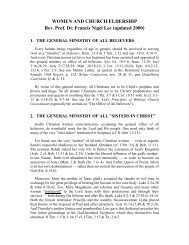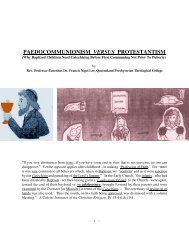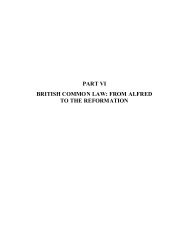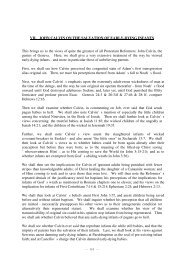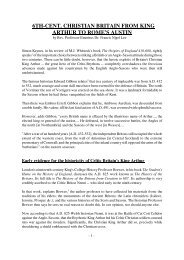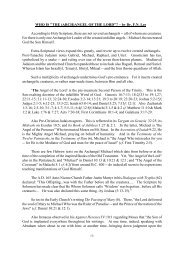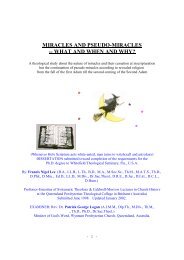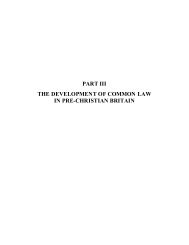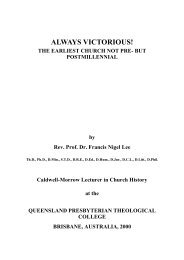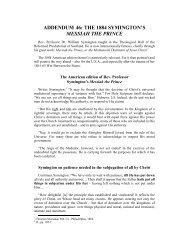Whites which ultimately led to severe dissatisfaction with England, and finally the AmericanDeclaration <strong>of</strong> Independence. So too in South Africa, from about 1710 onward we begin to find(some sixty years after the establishment <strong>of</strong> the White colony) the emergence <strong>of</strong> a South AfricanWhite consciousness.<strong>The</strong>se "Afrikaners" objected to the perceived authoritarianism <strong>of</strong> Holland. <strong>The</strong>y intensely dislikedthe autocracy <strong>of</strong> the foreign Dutch government -- and many <strong>of</strong> the Dutch noblemen and wealthypeople who were sent to South Africa from Holland to govern her. This clashed with the frontiertypespirit, where every man was regarded as formally the equal <strong>of</strong> every other civilized man.Some <strong>of</strong> these governors that were sent to South Africa were not even real Dutchmen. One suchwas a very objectionable individual called Willem Adriaan van der Stel. He was born in Indonesia.His father was a Dutchman, but his mother a Malay. He was really autocratic, and quite a tyrant. Hemuch upset the people, who were not large in number.In North America, the White population rapidly expanded not so much at the cradle but particularlythrough continuing immigration. <strong>The</strong> White colonisation <strong>of</strong> South Africa however -- after its initialestablishment in 1652 and the arrival <strong>of</strong> the French Huguenots in 1688 -- hardly got any newincrease whatsoever from Europe.What preserved a great deal <strong>of</strong> openness in White Americans toward White Europeans, is the factthat there has -- at any rate until just a few decades ago -- been a constant flow <strong>of</strong> more and moreEuropeans to the United States. That has not been the case in South Africa. <strong>The</strong> South AfricanWhites, once they got rooted, were remote and alo<strong>of</strong> from Europe. Until about 1820, almost theonly new arrivals were autocratic European rulers and Governors. <strong>The</strong>y came there for a five- orten-year term, not understanding the people. <strong>The</strong>n they had to be replaced by yet other autocraticand unsympathetic rulers.So the White population in South Africa expanded chiefly at the cradle. Through immigration from1700 onward, it increased at a very tiny trickling pace -- compared to the flood <strong>of</strong> immigrantswhich then kept on arriving in North America. In fact, by 1700 there were only 1800 Whites in thewhole <strong>of</strong> South Africa -- together with 1100 slaves. None <strong>of</strong> those slaves were from Africa. All <strong>of</strong>them had been transported there by Dutch slavers from Indonesia.Yet we find the White-born people in the Cape becoming increasingly more dissatisfied with theDutch colonial pressures from Holland. Indeed, it was especially the Huguenots -- the people <strong>of</strong>French Calvinist descent -- who were the most dissatisfied <strong>of</strong> all.Huguenots like Adam Tas became more and more involved in moving for increasing measures <strong>of</strong>South African self-government. <strong>The</strong>y disliked the Dutch control <strong>of</strong> the Cape. <strong>The</strong>se were peoplewho were sturdy, who had been grounded in Calvin's GaIlic Confession -- which required thegovernment to be godly in terms <strong>of</strong> the Ten Commandments. <strong>The</strong>y perceived that the far-awayDutch government no longer seemed to be very godly -- at least, not in its dealings with the SouthAfricans. So they began to say so, more and more.It is interesting that the man who wrote the music for the South African national anthem, Rev. M.L.de Villiers, is <strong>of</strong> French Huguenot descent. Indeed, the Huguenots were a people that lovedfreedom.So, Huguenots like Adam Tas with their strong law-orientation would appeal to Calvin and hisGalIic Confession. <strong>The</strong>y objected against the tyranny <strong>of</strong> wayward Dutch governors and <strong>of</strong>ficials atthe Cape -- and they resisted it. Throughout the eighteenth century, you had this. In 1740, 1750 and
1760 -- there was more and more dissatisfaction in and around Cape Town. People trekked over themountains and then across the rolling plains -- on and on into the arid heartland <strong>of</strong> South Africa.First <strong>of</strong> all, there was dissatisfaction round the lush coastal regions -- where alone there wasadequate rainfall. <strong>The</strong>re you find the rise <strong>of</strong> the first White South African nationalism, in a groupknown as the Cape Patriots. <strong>The</strong>se were people who began first requesting and then demandinginitially tokenistic, but later real political representation in their own affairs -- much as the NorthAmerican colonists began to agitate for this sort <strong>of</strong> thing also from about 1700 - 1720 onward.<strong>The</strong> dates are surprisingly parallel in the two continents. So too the development <strong>of</strong> events. <strong>The</strong>White South Africans felt that they wanted to be more autonomous in trading. Yet the Dutchmother country followed a closed trading pattern. It wanted to saddle South Africa with Dutchitems that White South Africans did not particularly want to buy. <strong>The</strong>y preferred to buy Frenchgoods or to make them themselves. This was leading up to a "Boston Tea Party" sort <strong>of</strong> situation --comparable with what happened in America from 1770 to 1776.Round about 1780, just as the Americans were winning their independence, a very major event tookplace in South Africa. <strong>The</strong> dissatisfied White settlers, as they moved eastward and northward awayfrom Cape Town at the southern tip <strong>of</strong> Africa where I grew up, for the first time suddenlyencountered Black people that they had never seen before. Thus the Whites had been in SouthAfrica for one hundred and twenty-eight years before they met the first Blacks. <strong>The</strong>y met in theeastern portion <strong>of</strong> what is now South Africa.<strong>The</strong> Whites had moved out eastward and northward from Cape Town. <strong>The</strong> Blacks had been movingdown from East Africa, southbound. <strong>The</strong>y moved on through the southeastern fringe <strong>of</strong> Africa --with other Black tribes to the north <strong>of</strong> them pushing these advancing Black tribes down into what isnow South Africa.One day, as the eastward-moving Whites went over the brow <strong>of</strong> the next hill and as the westwardmovingBlacks came over the brow <strong>of</strong> the same hill -- they looked at one another, and could notbelieve their eyes. <strong>The</strong> two groups did not understand one anothers language or culture. <strong>The</strong> Whiteswere Christians and Calvinists, and spoke a Caucasian language. <strong>The</strong> Blacks were half-nakedpagans with some Moslem influence. <strong>The</strong>y did not understand the Whites' language yet the twogroups still managed to make a deal.<strong>The</strong> point where they met one another on those hills, would be the boundary. <strong>The</strong> Whites wouldmove no farther to the east nor to the north. <strong>The</strong> Blacks would move no farther to the west and tothe south. Here is the second phase in the development <strong>of</strong> racial segregation -- as the historicalpractice <strong>of</strong> South Africa.Things might have gone well, if it had not been for a handful <strong>of</strong> greedy Whites who wanted to grabmore land to the east and the north <strong>of</strong> that border. <strong>The</strong>re was also more than a handful <strong>of</strong> starvingyet greedy Blacks who might well get wiped out in the next famine.Famines are very frequent in South Africa. Remember, it is desert country. <strong>The</strong>re is very little rain.When the Blacks had a crop failure and when their cattle began to die, they found it mostconvenient to raid their White neighbours' cattle. "Look, fellows ... meat!"Of course the Whites were not very happy with having their cows burgled. <strong>The</strong>y undertookreprisals, and this led from 1780 onward over the next couple <strong>of</strong> decades to the socalled Ten KaffirWars.
- Page 1 and 2: THE CHRISTIAN AFRIKANERSA Brief His
- Page 3 and 4: God richly bless the following lect
- Page 5 and 6: There have always been, and always
- Page 7 and 8: But the only one they both appeal t
- Page 9 and 10: Now Zuidema was a very great Dutch
- Page 11 and 12: Dutch churches at the Synod of Dord
- Page 13 and 14: station -- to help the Dutch ships
- Page 15: It is a country dedicated to freedo
- Page 19 and 20: with the Dutch. Many moved farther
- Page 21 and 22: said: "The British have placed our
- Page 23 and 24: financed by White money. It is buil
- Page 25 and 26: Famous Boer Generals, left to right
- Page 27 and 28: Three: Unannihilated: the Resurrect
- Page 29 and 30: (who had arrived in the country onl
- Page 31 and 32: of success.I may add that White Sou
- Page 33 and 34: General Beyers felt that those text
- Page 35 and 36: Balfour Declaration. The gist of it
- Page 37 and 38: Africa; treks on into the land both
- Page 39 and 40: Four: The Eschatology of Victory in
- Page 41 and 42: ide -- to use the instrumentality o
- Page 43 and 44: Christian National Calvinist Public
- Page 45 and 46: through constitutional process it h
- Page 47 and 48: I guess the best way to describe Sm
- Page 49 and 50: He was followed after his assassina
- Page 51 and 52: So the Scots came. I am going to sp
- Page 53 and 54: the Reformed Church in South Africa
- Page 55 and 56: ook on Hebrews. But his greatest wr
- Page 57 and 58: At that point, Du Plessis enquired
- Page 59 and 60: Yet quite apart from this high view
- Page 61 and 62: One last point. There is a tremendo
- Page 63 and 64: African Republic in 1902, the Cape
- Page 65 and 66: One of the most important Calvinist
- Page 67 and 68:
Pellissier, who wrote on music and
- Page 69 and 70:
perspective -- even while he minist
- Page 71 and 72:
ever encountered by the Whites in S
- Page 73 and 74:
Now the United States does not need
- Page 75 and 76:
majority of the White citizens are
- Page 77 and 78:
Now you will not find in any of Sto
- Page 79 and 80:
Finally, Stoker argues that the so-
- Page 81 and 82:
This then brings Stoker to another
- Page 83 and 84:
This Brummer just referred to, is a
- Page 85 and 86:
Man was to rejoice in this nature (
- Page 87 and 88:
enhanced. For, in the present, man
- Page 89 and 90:
he declared, riddled with the ungod
- Page 91 and 92:
Van der Waal is a very brilliant So
- Page 93 and 94:
World War II when he was hiding fro
- Page 95 and 96:
The Professor of Philosophy -- or I
- Page 97 and 98:
glory.There are also Christian psyc
- Page 99 and 100:
Then there are Christian criminolog
- Page 101 and 102:
Massachusetts at Gordon- Conwell fo
- Page 103 and 104:
well known -- is being pioneered in
- Page 105 and 106:
people in South Africa. The South A
- Page 107 and 108:
nature and of human culture (Prover
- Page 109 and 110:
The parousia of Jesus Christ will i
- Page 111 and 112:
more and more christianised. Later
- Page 113:
END



